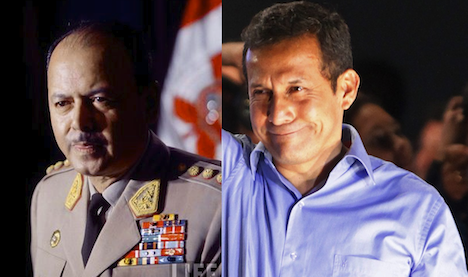It hardly seems like Ollanta Humala has been Perú’s president for two years — it feels like yesterday when we were assessing Humala’s first year in office.![]()
Jacob Bathanti, a Latin American scholar who blogs occasionally from Lima, where he’s working this summer, considers the similarities between Humala (pictured above, right) and his leftist military predecessor Juan Velasco Alvarado (pictured above, left), and also to Fernando Belaúnde. But he also places Humala within an even broader tradition — here, in one sentence, he’s encapsulated mainstream Peruvian policy from much of the past half-century:
Official Lima, in so many manifestations, has always seethed with anxiety over these people, what they might do next (when it isn’t ignoring them). Humala’s big idea seems to be to resist the temptation to ignore the highlands, to push a broad economic integration into the national prosperity, satisfying the economic needs of those most likely to revolt – because it is in their nature, because they are sick of poverty, because to revolt is unfortunately at the moment justified, heck, pick a reason – before they revolt again.
But with three years left to go in his presidential term, Humala remains in many ways a chimera whose once-leftist rhetoric has dissolved into a presidency that seems to have no prevailing ideology. That’s why it’s so tantalizing to look back to the Velasco years as a template for what Humala may yet try to accomplish — will he take up Velasco’s primary cause of pushing the fruits of Perú’s economic boom further down to the country’s poorest citizens? Perú is somewhat remarkable among Latin American countries in that party identification remains incredibly weak, there’s no strong center-left and center-right party as such, and leaders easily slip from left to right and back again. Humala’s predecessors, Alan García and Alejandro Toledo, both had their fair share of chameleonic moments in public life.
What Jacob writes comes as close to articulating, in one sentence, Perú’s prevailing 21st century ideology as I’ve ever read, and it really applies to just about every government in recent Peruvian history, except perhaps two. The first is García’s first presidency from 1985 to 1990, which was a hyperinflationary socialist economic disaster. The second is the authoritarian presidency of Alberto Fujimori from 1990 to 2000, which began amid a low-grade civil war against the communist Sendero Luminoso (Shining Path).
I find the comparison to Velasco particularly intriguing because it’s so rare that an army coup results in a leftist military-led government in Latin American history, and the similarities to Humala, the once-radical military man are simply too great to ignore. In 2000, Humala led a short-lived anti-corruption revolt from within the military against Fujimori. As it turns out, the revolt fizzled, Fujimori fled shortly thereafter and Humala was pardoned, but the similarities are hard to miss. In the 2006 presidential campaign, Humala often cited Velasco as a political touchstone and even went so far as to say that his administration would finish the work that Velasco’s started.
Like Velasco and many before him, Humala is trapped between meeting the needs of a business elite that has kept GDP growth humming along (an elite that largely supported his opponent Keiko Fujimori in the June 2011 presidential race) and a restless majority still trapped in poverty (that largely placed its hopes in Humala). The Peruvian economy is likely to dip to just 6% growth this year — still high, but troubled by slack Chinese growth, flat prices for gold, copper, oil and other commodities that comprise over two-thirds — but protests over Humala’s performance in office continue, and polls show that his popularity has declined from over 50% earlier this year to just 33% this summer.
But Humala has governed in a far different manner than Velasco on two of the most important matters of Peruvian governance — economic policy and foreign policy. Continue reading Is Peru’s Humala a modern-day Velasquista?
